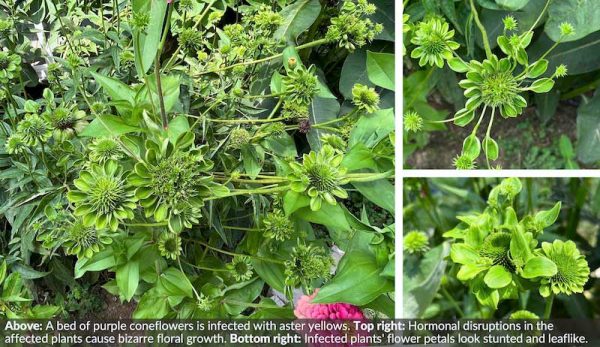
Between more extreme weather than usual and an onslaught of head-clipping weevils, my butterfly garden took a beating this season. Usually I don’t have to do much to keep my milkweed, black-eyed Susans and other native perennials looking their best. But within a particularly dense planting of purple coneflowers, things went off the rails when aster yellows disease moved in.
The large, purple flower heads I expected to see were replaced with blooms right out of a Dr. Seuss book. Green, leafy “petals” ringed bright green cones. Weirder still, in some spots the leaf-like petals were replaced with additional flower stalks—also sickly green and badly deformed.
At first I thought it was just some genetic anomaly. Looking into it further, I realized the news was much worse—a classic case of aster yellows disease.
Aster What?
Caused by a phytoplasma—a special type of bacterial plant pathogen—aster yellows disease is transmitted by leafhoppers. According to John Bonkowski, a plant disease diagnostician at Purdue University’s Plant and Pest Diagnostic Laboratory, “What typically occurs is the phytoplasma will be within the gut of the leafhopper. So, while feeding, a leafhopper pokes its piercing, sucking mouthpart into the leaf and sucks out some of the [the leaf’s] contents. They sometimes also push out saliva, and the phytoplasma comes out when they do that. It goes into the plant.”
A kind of parasite, phytoplasmas are bacteria that lack cell walls. As such, they cannot live outside on their own. “They need to be inside the host,” Bonkowski says. “That’s why they’re being moved around by the insects.”
Echinacea plants are among the most commonly affected by aster yellows disease. However, marigolds, zinnias, daisies and chrysanthemums are some other susceptible targets.
Disease Symptoms
Once an infected leafhopper transmits the disease-causing phytoplasma to a plant, the entire plant is systemically affected. “It’s going to be throughout the plant,” Bonkowski says. “The phytoplasma can affect the hormone balance in the plant, which is why you end up seeing these very particular symptoms in coneflower and zinnias and these other aster plants.”
“Flower parts will start developing leaves,” he adds. “So, in the case of echinacea, you have the cone itself—the spiky part—and it actually will start developing bunches of leaves.”
In general, plant growth may be very stunted and small. “There might be more stems compared to what a normal plant would produce,” Bonkowski says. “You’ll have these offshoots that are very green and maybe smaller than you might expect on a typical flower. The big thing is that the hormone balance is disrupted, and you have these odd plant growths because of it.”
The Fix
When it comes to eradicating aster yellows in affected plants, there’s really no good treatment. What’s more, simply pruning them down to the ground isn’t enough. “The aster yellows phytoplasma will not survive in the debris of infected plants. But it can survive in the crown and roots of infected perennial plants,” Bonkowski says.
If the bacteria that caused aster yellows is allowed to remain in perennial plant roots, subsequent new plant growth could be affected. Your best bet? Get out the shovel and start digging. “It’s best to remove any kind of [infected plant] material, because [the bacteria] could be present throughout,” he says.
“It can get pretty bad if there’s a high infestation of the leafhopper and they’re moving [the disease] around,” Bonkowski says.
Still, trying to control the spread of aster yellows by killing off the leafhoppers simply isn’t practical. “Even in trying to manage the insects themselves, they’re everywhere,” he notes. “So, it’s not usually feasible in a home garden, because they can come in from another location nearby. Even if you do apply a protective kind of insecticide, you might kill some of them, but more might have the opportunity, after you apply something, to come in and, once again, feed on plants.”
Insecticides are also problematic since they kill indiscriminately. That means you could end up harming valuable insect pollinators—not to mention some of the beneficial insects that naturally feed on leafhoppers.
Last Steps
Once infected plants have been dug up, they need to be disposed of carefully. To be on the safe side, you can bag up the diseased plant material and throw it away. (Just be sure to check local laws first, since it’s illegal to toss out residential plant matter in some areas.) Alternatively, you can dig a deep hole in the ground and bury the plant refuse.
Last but not least, periodically check any remaining plants for signs of new infection. Pull and dispose of additional, infected plants as needed.




